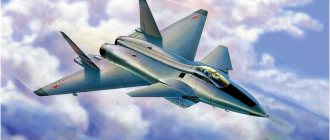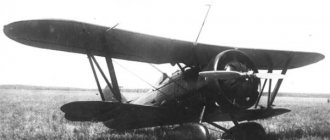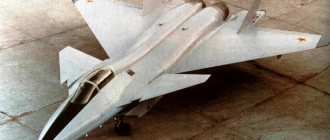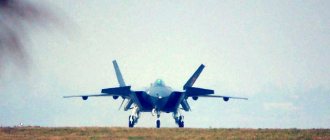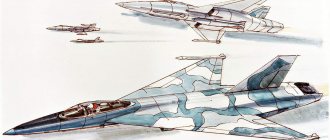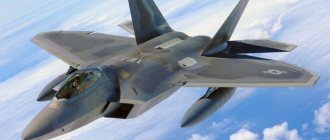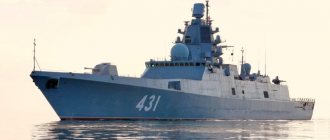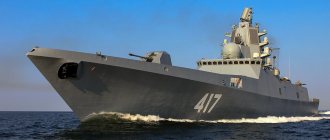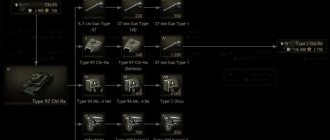| MiG 1.44 MFI | |
| MiG 1.44 at MAKS-2015 | |
| Type | multi-role fighter |
| Developer | USSR→ Russia MiG |
| Manufacturer | Moment |
| First flight | February 29, 2000[1] |
| Status | The project is closed |
| Units produced | 1 |
| Media files on Wikimedia Commons | |
MiG 1.44 MFI
(from multirole front-line fighter; in the series it was supposed to be called
MiG-35
; according to NATO codification:
Flatpack
[2]) is a Soviet and Russian experimental prototype of a fifth-generation fighter.
History and general information
Preliminary work on the creation of a fifth-generation heavy fighter for the Air Force and Air Defense began at the end of 1979 as part of the I-90 program (“fighter of the 1990s”). In 1981, TsAGI issued recommendations for an aircraft made according to the “canard” design with a delta adaptive wing and a large number of deflectable surfaces, providing high values of aerodynamic quality in both subsonic and supersonic modes, as well as flight at supercritical angles of attack.
The development of a new fighter began at the A. I. Mikoyan Design Bureau. In 1983, a “Comprehensive Target Program” of work on the aircraft, power plant, avionics and weapons was approved, as well as tactical and technical specifications for the Air Force and Air Defense. In 1987, the defense of the preliminary design took place, and in 1991, the preliminary design and mock-up of the aircraft, which received the index “MFI” - a multifunctional front-line fighter. Its main features were to be:
- super maneuverability;
- improved takeoff and landing characteristics;
- a significant reduction in the cost of a flight hour, the amount of technical personnel, the volume and weight of non-standard equipment required to maintain the aircraft;
- new architecture of the avionics complex, structure of the cockpit information and control field, high degree of integration;
- In theory, it should have been equipped with the N014 radar, with a range of 420 km and the ability to detect an object with an area of 1 m² at a distance of 250 km; tracking 40 targets and firing 20 simultaneously; Passive electronically scanned array antenna.
In parallel with the work on a multifunctional front-line fighter based on the basic design, variants of a reconnaissance aircraft, a ship-based fighter and other modifications were being developed.
The crisis that broke out in 1991 put an end to the future fate of the aircraft. MAPO-MIG was unable to organize financing for the project under the new conditions. On September 25, 1997, the prototype of the S-37 front-line fighter (Sukhoi Design Bureau) took off - the MiG 1.44 had not taken off by that time.
Work on the MFI continued and on February 29, 2000, the first MiG 1.44 prototype took off. But a series of financial scandals that rocked MAPO-MIG put an end to this project. As a result, in 2002, a government decree was issued on the creation of the Su-57, which finally buried both the MFI and the S-37.
As of 2013, the only flightable prototype is located at the Flight Research Institute named after M. M. Gromov in Zhukovsky, abandoned in the open air (coordinates - 55°34′27″ N 38°08′32″ E HGЯO). A decision was made to permanently preserve the specimen in the hangar.
Among a number of experts, there is an opinion that some technologies and general types of the aircraft were transferred to China, although, most likely, the Chinese, when creating their J-20, used developments from their own J-10 aircraft.
In June 2015, the Russian aviation corporation MiG announced the resumption of work on a promising light fighter[3]. Aviation experts suggest that they will be based on developments from Project 1.44.
Modifications
Airplane with code 1.42
is a prototype on which the technologies of the MiG design bureau were tested under the I-90 project. 1 prototype built (1994) which was used for static testing.
Airplane with code 1.44
is a modified 1.42. He had to go into mass production and enter the army. 1 copy was built (1996), 4 more were in varying degrees of readiness at the time of project closure.
Airplane with code 1.46
is a deep modernization of 1.44, significantly superior to it in terms of performance characteristics. At the time the project was closed, preparations were underway for the construction of a prototype.
Specifications
MiG-MFI in four projections MiG-MFI in four projections
- Crew:
1 person - Length:
17.3 m - Wingspan:
11.99 m - Height:
4.73 m - Weight: empty:
18000 kg - maximum take-off weight:
23500 kg
- Engine type:
turbojet bypass with afterburner and thrust vector control
"AL-41F"
2 × 18000 kgf
Flight characteristics
- Maximum speed at altitude:
3210 km/h - Maximum ground speed:
1500 km/h - Practical range:
4000 km - Service ceiling:
20000 m - ESR:
less than 0.3 m²
Armament
- Cannon:
30 mm built-in cannon GSh-30-1 - Combat load:
up to 1600 kg
for air combat, in weapons bays:
12 × R-77 or R-73 - against ground targets, in weapons bays:
2 × Kh-55, Kh-61, Kh-41, or 8 × Kh-29, Kh-31, or 12 × KAB-500, ODAB-500
- internal:
12
8
Main characteristics
The aircraft was developed by RSK MiG. The main distinguishing feature is its widest functionality, which makes it possible to use the machine in a wide variety of conditions. It is also available in an export version, there is a modification with a double cabin. The new MiG-35 aircraft, a photo of which is in the article, is very similar to its predecessor (Mig-29), but is a fundamentally different machine.
All modifications of these machines are fundamentally new aircraft. The main distinguishing feature is the increased flight range, completely updated on-board equipment, enhanced on-board weapons, as well as the ability to carry more attachments and ammunition.
The MiG-35 fully implemented the HOTAS principle. What does it mean? The fact is that during the flight, all the information necessary for the pilot is displayed directly on the glass of the cockpit canopy. For this, three “displays” are used at once. This concept allows the pilot to conduct air combat without being distracted by instrument control.
In popular culture
The MiG-MFI is present in the video games Jetfighter V: Homeland Protector, Jetfighter 2015, Ace Combat 5: The Unsung War, Ace Combat X: Skies of Deception, Command & Conquer: Generals, Command & Conquer: Generals Zero Hour, Ace Combat X2: Joint Assault, Tom Clancy's HAWX 2, Ace Combat: Assault Horizon Legacy, Ace Combat: Infinity. It is worth noting that the reflection of the tactical and technical characteristics of aircraft and the features of its use in combat in many computer games is often far from reality.
The Russian company also produces a kit model of a fighter in 1/72 scale.
Power point
As such, RD-33MK engines are used, which are in many ways similar to those for the MiG-29K. The manufacturer reports that for some customers power plants with variable thrust vectoring can be installed. These are the engines that are installed on every MiG-35 aircraft, which is designed to demonstrate aerobatics.
The design uses a gas turbine unit of the GTDE-117 type, producing at least 66.2 kW of power. Fuel is supplied from five tanks located in the fuselage of the aircraft, as well as two wing compartments. Their total standard capacity is 4300 liters.
Development trends of modern combat aircraft
Today, all over the world, there is an increasingly clear trend towards multirole fighters becoming two-seat. As we have already said, the MiG-35 was no exception. What is the reason for the desire of design bureaus to increase the crew?
When testing the Ka-50 helicopter, the military found out that when operating in air-to-ground mode, the load on the pilot increases incredibly: the pilot not only has to fight, but also monitor the readings of dozens of instruments. All this was taken into account when designing not only the Ka-52 helicopter, but also when creating the new MiG-35 aircraft.
It was because of this that the decision was made to seat two pilots in the cockpit, so that one of them piloted the plane, and the second fought the air battle. Considering that the speed of the MiG-35 exceeds that of sound, this solution not only reduces the load on operators, but also significantly increases the survivability of the vehicle as a whole.
Flight characteristics
In general, the 35th model was developed precisely so that pilot training would take as little time as possible. For example, cadets can almost be directly transferred from training simulators based on the MiG-29. Currently, new versions of simulators are being developed that would present the MiG-35 aircraft in a ship version.
But the aircraft also has one more important advantage, expressed in the extreme simplicity of its operation. The fact is that our troops today are largely equipped with MiG-29M and 29K. Accordingly, servicing a car that is almost completely identical to them will be much easier than a completely new aircraft.
Among other things, experts note that the modernization potential of this model may be sufficient until 2040.
Pilots' workplaces
As we have already said, three information displays are placed on the “windshield” of the cockpit canopy. By the way, the cabin itself is virtually identical to that of the ship's Mig-29K.
The developers did this because the pilots spoke most positively about this option. Four multifunctional indicators are also installed in the second cockpit, and one of them duplicates the basic information from the first pilot’s cockpit.
By the way, in the single-seat version of the MiG-35 aircraft, an additional fuel tank is installed in place of the second cabin.
Information on the modern operation of the MiG-29/35 in the RF Armed Forces
At the moment, our country’s troops have about 400 MiG-29 vehicles of new modifications. It is reported that starting this year the MiG-35 fighter will begin to be actively supplied to the troops. Today, the active army has no more than a few dozen vehicles of this class, but the transition to them will clearly be carried out at an accelerated pace.
This is largely due not only to the mass rearmament program (until 2022), but also to the fact that the design of the 29 MiGs began to reveal fatal flaws associated with the catastrophically rapid wear of some tail parts. In particular, in 2008, one pilot died for this reason.
Currently, only those aircraft that have undergone a full technological inspection are allowed to fly. Projects of the defense department are already being considered, according to which almost every second MiG-35 fighter will represent a deep modernization of aircraft already in service.
However, the military themselves are very skeptical about this idea: many vehicles of this class were produced back in the USSR, so their operational life has long been exhausted.
Prospects
One should not think that only the domestic military was interested in the new development. The Malaysian Air Force has repeatedly spoken out about the advantages of using Russian multirole fighter-bombers. Representatives of the Indian Armed Forces spoke about the same thing.
Unfortunately, even the excellent characteristics of the MiG-35 did not save it from behind-the-scenes intrigues, when the supply of Russian aircraft was cut off at the root by the reluctance of the Indian side to repeat the risks of the 90s. Then the entire army of the country found itself without material support.
The reason is simple - the Russian military-industrial complex in those years was not at all concerned with ensuring exports, but India can also be understood.
Currently, domestic specialists are working not only on export deliveries of new MiGs, but also on re-equipping domestic flight regiments with them. In particular, it has already been announced that the aircraft carrier Admiral Gorshkov will be equipped with them.
b YABGKH I ONEBKEMKHEL BYURKHYUMRNB lHts-25, OREDMYUGMYUVEMMSHU DK ANLANLERYUMKH, ONEBHKYUYAE H yVEAMYU BERYAH RUYNTSN YYULNKERYU. lHts-25ps(ХГД.39) - DBSULEYARMSHI SVEAMN-RPEMKHPNBNVMSHI BYUPHYUMR PUGBEDVKHYU lHts-25p, ON YNMYARPSYZHHH YUMYUKNTSKHVEM DBSULEYARMNLS BYUPHYUMRS OEPEUBYURVHYU lHts-25os.
nRKHVYUERYA NANPSDNBYUMHEL YYUAKHM X NRYASRYARBHEL ONDIPSHKEEBSHU OKKNMNB. YANGDYUM B 1970 Ts. oEPBSHI BSHKER MU TsNKNBMNL YAEPKHIMNL YAYULNKERE lHts-25ps (No.0101) BSHONKMHK 20 LYUPRY 1971 Ts. KERVKHY schKEIKHMAYUPD. YaYULNKERSH lHts-25ps YARPNHKHYAE YEPKHIMN B TsNPAINL B 1970-1982 TsTs., BSHOSYEMN ANKEE 50 SHYGELOKPNB. b 1975-1978 CC. MU YAYULNKERE lHts-25ps, ONKSVKHBYEL NANGMYUVEMHE e-133, KERVKHYNL-HYAOSHRYUREKEL i.e. YaYUBKHZHYNI SYARYUMNBKEMN MEYAINKEIN FEMYAYKHU LHPNBSHU YUBKHYUZHNMMMSHU PAINPDNB.
SHYYAONpRMSHI BYURKHYUMR lHts-25ps ME pYUGRYUAYURSHBUKYA KH ONSHCHRNLy ON GYUYUGy xMDXX ASHKN HGTSNRNBKEMN 2 YAYULNKERYU, YUAYANKCHRMN KHDEMRKHVMSHU YANBERYAIHL.
NDHM HG YAERKHIMSHU YYULNKERNB lHts-25ps pYUMMKHU YAERKHI (No. 390yayu01) ASHK OEPENANRYDNBYUM DK NORNANBYUMKH YURYUOyKERKHRYELSHU YPEYAEK y-36pa, OREDMYUGMYUVEMMSHU DK YNYALKHVEYAYNTSN YNpYUAK “aypYUM”.
ypEYAKYU I LUMEYEMYULH BSHYARREKHBUKKHYAE I YANNRBERYARByCHYETSN ORKHYAONYANAKEMH, pYUYAONKNFEMNTSN B GYUDMEI YUAHME. schryu YYUAHMYU ME HLEKYU TNMYUR, BLEYARN METSN ASHKKH MYURYUYEMSH LERYUKKKHVEYAYKHE ANRPKHYKH ON ANYYUL, YU YAOEDH yYARYUMNBKEM LERYUKKKHVEYAYKHI YNGSHREY. YABEpUy YUAHMY NYARYUKYUYAE NRYPSHRNI. b MNYANBNI VYUARKH TCHGEKKFU pYUGLEYUKYA MEANKENNI YNMREEIMER I BKhDENYULERNI, TKHYAHRYCHYEI LNLEMR YURYUOyKERKHpNBYUMKH. ON NYNMVYUMHH HYAOSHRYUMKHI B pYULLYUU ORNTspYULLSH "ayrYUM", YAYULNKER "01" HYAONKEGNBUKYA DK HYAOSHRYUMKHI DpyTSKHU YURYUOyKERMSHU YPEYAK. YaEIVYUYA SHCHRYU LYUHMY MUUNDHRYA B khkh HL.tsPNLNBYU. cru:
| lNDHTHYUZHH | lHts-25ps |
| pYUGLUU YPSHKYU, L | 13.42 |
| dKKHMYU YAYULNKERYU,L | 21.55 |
| bSHYANRYU YAYULNKERYU,L | 6.50 |
| OKNYYUDE YPSHKYU, L2 | 61.40 |
| I love it, JC | |
| OSYARNTSN YYULNKERYU | 18760 |
| MNPLYUKEMYU BGKERMYU | 36720 |
| RHO DBKHTSUREK | 2 rpdt p-15a-300 |
| rtsyu, ytsya | |
| AEYATNPYUFMYU | 2 U 7500 |
| TNPYUFMYU | 2 U 11200 |
| LYUYAKHLYUKEMYU YAYNPNYARE, YL/V | |
| MU BSHIANRE | 2800 |
| WITH GELKH | 1200 |
| oEPETSNMNVMYU DUKEMNYARE, YL | 2400 |
| oPUYRHVEYAYU DUKEMNYARE, YL | 1200 |
| oPUYIRKHVEYAYKHI ONRNNKNY, L | 20000 |
| lyuYa. SHYYAOXYURYUZHNMMMYU OEPETSPSGYU | 4.5 |
| ShYKHOYUF, VEK | 2 |
| bottom. KhMTNPLYUZHKH: |
| tNRNTsPYUTHH: | lHts-25ps (c) ЯПЦИ вУИНБЯИХИ |
| lHts-25ps (c) EBTSEMKHI bNKYNB | |
| lHts-25ps (c) JEPCEI KNYREB | |
| lHts-25ps (c) dLKHRPKHI VSYKHM | |
| lHts-25ps (c) h.i. | |
| lHts-25ps (c) EBTSEMKHI bNKYNB | |
| lHts-25ps (c) JEPCEI KNYREB | |
| lHts-25ps (c) JEPCEI KNYREB | |
| lHts-25ps (c) yaEPTSEY yuAKNTsKHM | |
| yYUAKHMSH lHts-25ps (c) yEPTSEY vYUIINBYAIKHI |
IWELSH:
| bYUPHYUMRSH lHts-25ps |
bYUPHYUMRSH NYPYYAYH:
| oPNRNRHO lHts-25ps |
| lHts-25ps |
| lHts-25ps 2 yushch 47 tsB.pyo (c) b. gNKNRNB |
| lHts-25ps bbya xMDXX |
| lHts-25ps kxx HL. tsPNLNBYu (c) YuKEYYYUMDP tsYUBPKHKNB |
| YaOHYANY HYARNVMKHYNB: |
| yPSHKE pNDHMSH 1993-02-03. bKYUDHLHP xKEHM. "YUMTSKKHIYAYU TSNMVYU" I YPYYUYAMSHLH GBEGDYULH yBKHYUYNKKEYZHKH 2010-05. m. YSANBHV. lMNTSNZHEKEBNI YAYULNKER lHts-25 lHP YUBHYUZHHH 1998-03. YuKEYAYUMDP kYuPKHNMNB."tsYUYARPNMNL" HKKH "ME OND NRYPSHRSHL MEANL YAOKHL" yuBKHYUZHKH YNYALNMYUBRKHYU. eTHL cNPDNM. LHts-25 YuBKHYUZHKH bPEL 2004-05. eTHL cNPDNM. YARYUKEMYU ORKHZHYU UBKHYUZHKH YNYALNMYUBRKHYU 2002-10. EBTSEMKHI ONDPEOMSHI. YARYUKEMNI "Foxbat" HG mHFMETSN mNBTSNPNDYU hYARPEAHREKE. lHUYUHK mHYNKEYAYKHI. lHts-25 — MEYAAHBUELSHI KHYARPEAHREKE Altair. Jefim Gordon, Oleg Putmakow. MiG-25 Stalowa Blyskawica Monigrafie Lotnicze 3. Piotr Butowski. MiG-25, MiG-31 Red Star 34. Yefim Gordon. Mikoyan MiG-25 Foxbat Russianplanes.net. lHYNYM-tsSPEBHV lHts-25ps |
sTSNKNY MEAYU. 2019
Differences between the MiG-35 and the old model
Despite the fact that the design was based on the 29M model, the new aircraft was unified with the 29K. The power plant and control system, cockpit and wing structure are almost the same. In many ways, the only difference is the significantly lightweight chassis design.
In general, MiG-35 fighters are in many ways similar to shipborne aviation systems. Even the anti-corrosion coating was designed to ensure maximum unification. This approach to the production of old and new aircraft at the same plant.
But the avionics on these machines are completely different. In particular, a phased array radar station is installed there, as well as an excellent defensive aircraft complex, which includes several active and passive defensive systems. Many of them are multifunctional.
